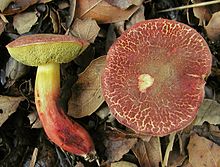| Xerocomellus dryophilus | |
|---|---|

| |
| Scientific classification | |
| Domain: | Eukaryota |
| Kingdom: | Fungi |
| Division: | Basidiomycota |
| Class: | Agaricomycetes |
| Order: | Boletales |
| Family: | Boletaceae |
| Genus: | Xerocomellus |
| Species: | X. dryophilus |
| Binomial name | |
| Xerocomellus dryophilus (Thiers) N. Siegel, C.F. Schwarz & J.L. Frank (2014) | |
Xerocomellus dryophilus, commonly known as the oak-loving bolete and formerly known as Boletus dryophilus or Xerocomus dryophilus, is a basidiomycete fungus in the family Boletaceae native to North America. It appears to only occur under the coast live oak (Quercus agrifolia), and is only found in California, where it is one of the most common boletes in the Los Angeles and San Diego counties.
It is commonly parasitized by Hypomyces chrysospermus.
It was transferred to the new genus Xerocomellus in 2014.
This epithet had been previously applied to a European species, now described as Xerocomellus redeuilhii.
References
- Stevens, Michael Wood & Fred. "California Fungi: Xerocomellus dryophilus". www.mykoweb.com. Retrieved 2021-11-16.
- ^ Arora, David (1986). Mushrooms demystified: a comprehensive guide to the fleshy fungi (2nd ed.). Berkeley: Ten Speed Press. ISBN 0-89815-170-8. OCLC 13702933.
- Simonini, Giampaolo; Gelardi, Matteo; Vizzini, Alfredo (2016). "Xerocomellus redeuilhii sp. nov". Rivista di Micologia.
External links
Species of fungus| Xerocomellus dryophilus | |
|---|---|
| Pores on hymenium | |
| Cap is convex or flat | |
| Stipe is bare | |
| Spore print is brown to olive-brown | |
| Edibility is edible | |
- [REDACTED] Media related to Xerocomellus dryophilus at Wikimedia Commons
- Xerocomellus dryophilus in Index Fungorum
| Taxon identifiers | |
|---|---|
| Xerocomellus dryophilus | |
| Xerocomus dryophilus | |
| Boletus dryophilus | |
This Boletales-related article is a stub. You can help Misplaced Pages by expanding it. |